Structure and Strategy: Holacracy and Organizational Design Report
VerifiedAdded on 2023/06/13
|7
|1262
|438
Report
AI Summary
This report delves into the intricate relationship between organizational structure and strategy, particularly in the context of rapidly evolving global business environments. It examines Yves Morieux's claim that structure follows strategy, highlighting instances where this principle holds true and cases where organizations deviate, often leading to inefficiencies. The report also explores the concept of holacracy, contrasting it with traditional bureaucracy and team-based structures, using Zappos as a case study to illustrate the practical implications of implementing such a system. Furthermore, it discusses the crucial link between innovative culture and agile organizational structures, emphasizing the importance of fostering creativity and risk-taking within organizations to drive performance and adapt to changing market dynamics. The report concludes by underscoring the necessity for companies to continuously adapt their corporate strategies to remain competitive in the modern business landscape, with Desklib offering additional resources for students seeking further insights and solved assignments on this topic.
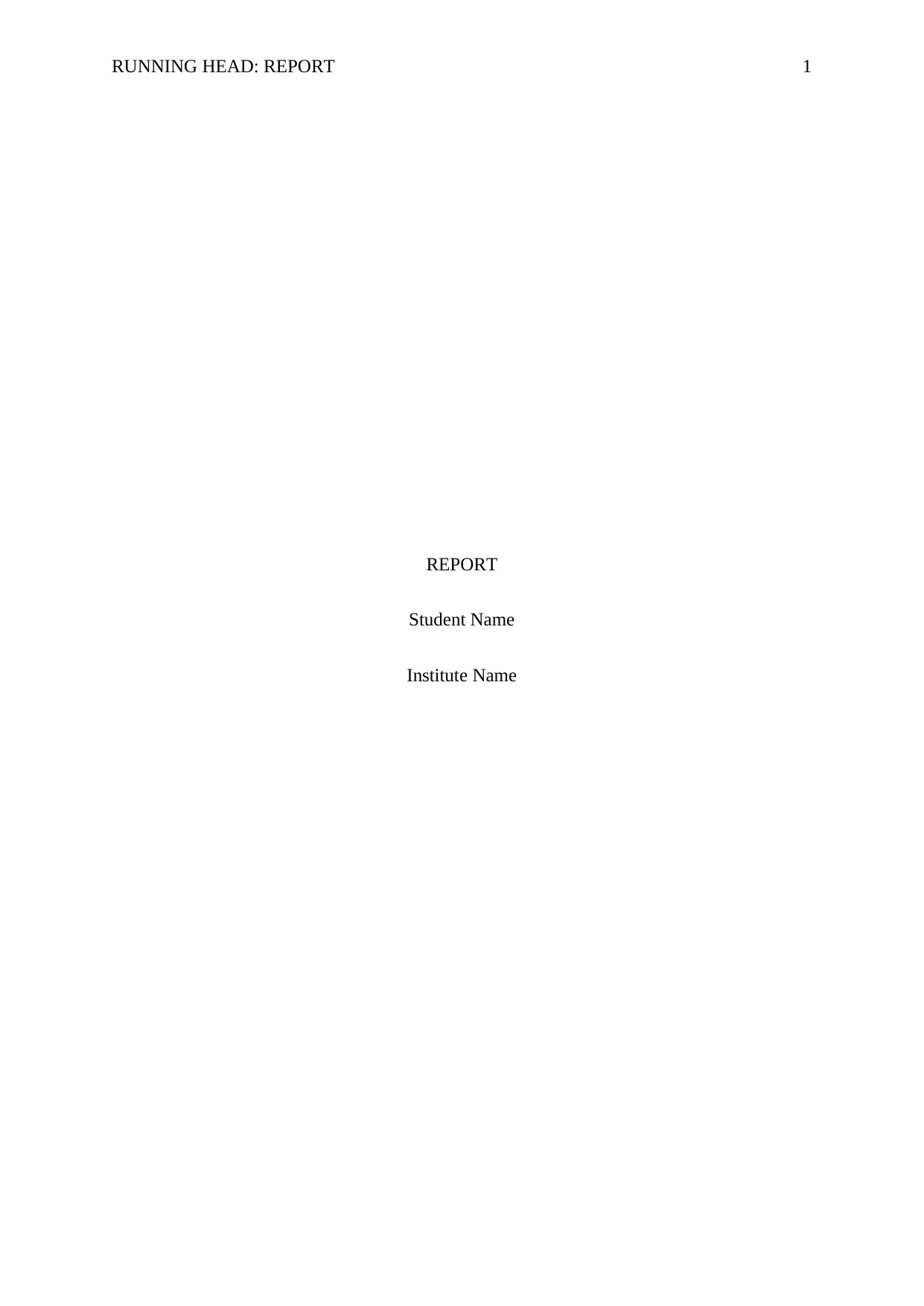
RUNNING HEAD: REPORT 1
REPORT
Student Name
Institute Name
REPORT
Student Name
Institute Name
Paraphrase This Document
Need a fresh take? Get an instant paraphrase of this document with our AI Paraphraser
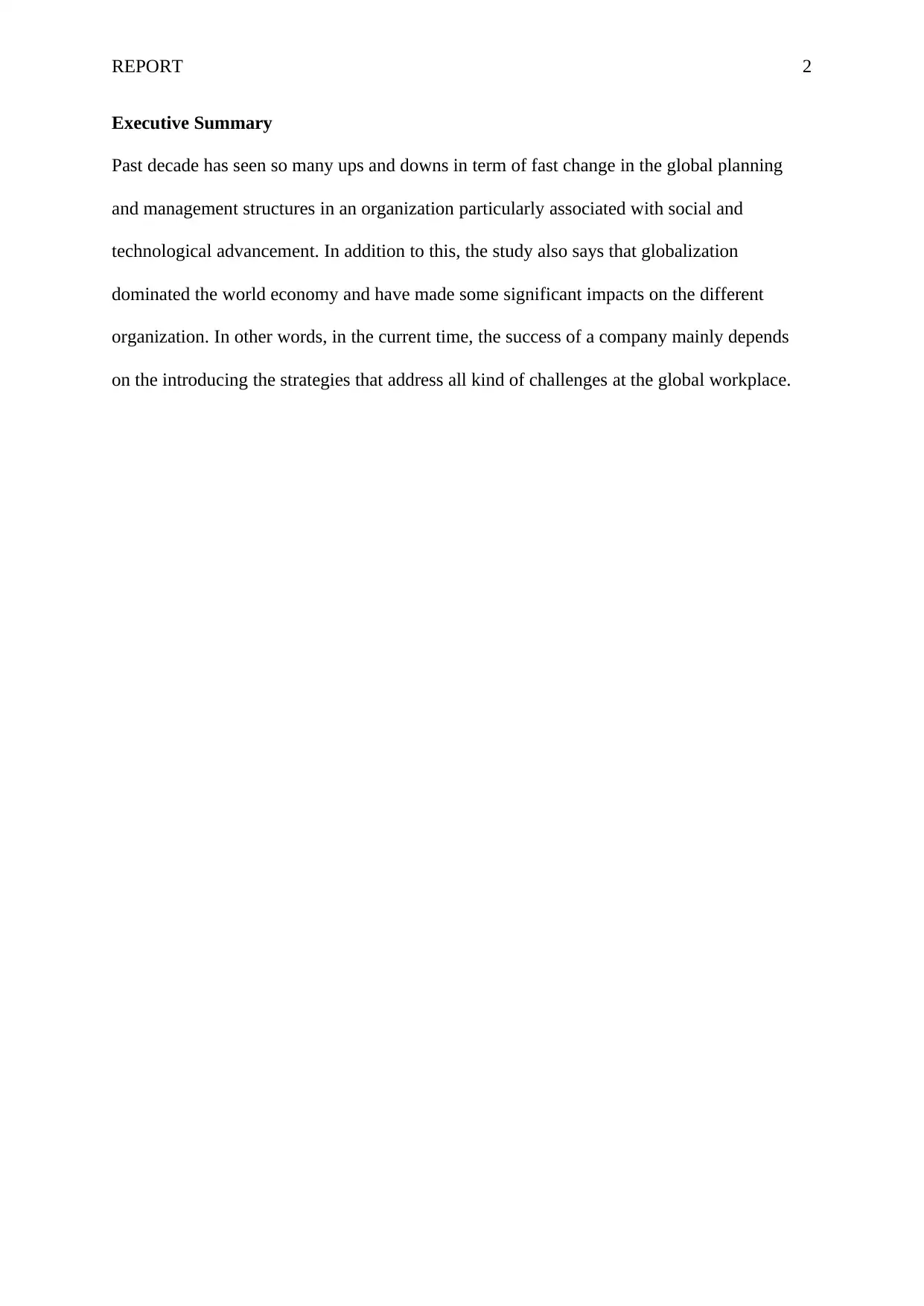
REPORT 2
Executive Summary
Past decade has seen so many ups and downs in term of fast change in the global planning
and management structures in an organization particularly associated with social and
technological advancement. In addition to this, the study also says that globalization
dominated the world economy and have made some significant impacts on the different
organization. In other words, in the current time, the success of a company mainly depends
on the introducing the strategies that address all kind of challenges at the global workplace.
Executive Summary
Past decade has seen so many ups and downs in term of fast change in the global planning
and management structures in an organization particularly associated with social and
technological advancement. In addition to this, the study also says that globalization
dominated the world economy and have made some significant impacts on the different
organization. In other words, in the current time, the success of a company mainly depends
on the introducing the strategies that address all kind of challenges at the global workplace.
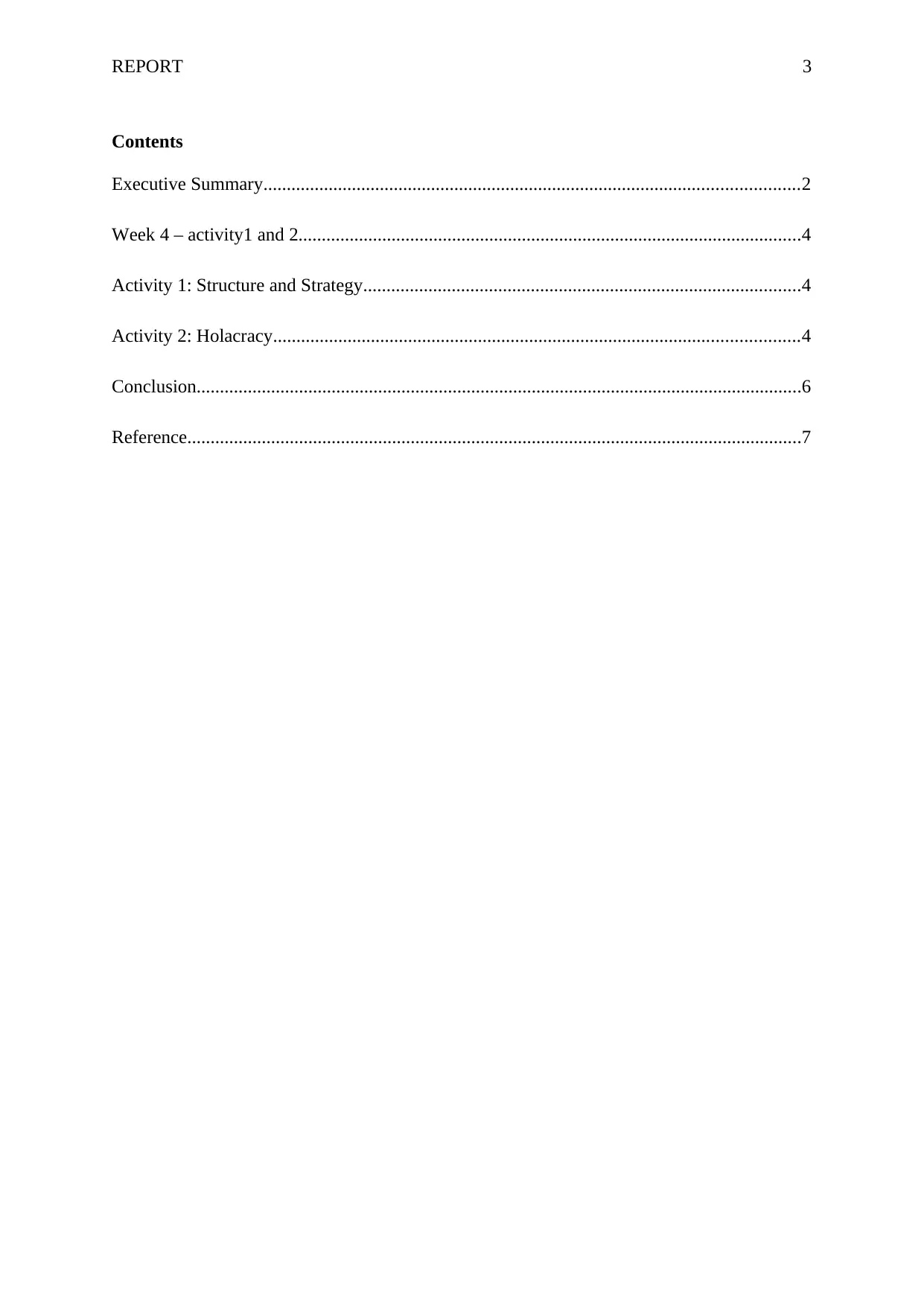
REPORT 3
Contents
Executive Summary...................................................................................................................2
Week 4 – activity1 and 2............................................................................................................4
Activity 1: Structure and Strategy..............................................................................................4
Activity 2: Holacracy.................................................................................................................4
Conclusion..................................................................................................................................6
Reference....................................................................................................................................7
Contents
Executive Summary...................................................................................................................2
Week 4 – activity1 and 2............................................................................................................4
Activity 1: Structure and Strategy..............................................................................................4
Activity 2: Holacracy.................................................................................................................4
Conclusion..................................................................................................................................6
Reference....................................................................................................................................7
⊘ This is a preview!⊘
Do you want full access?
Subscribe today to unlock all pages.

Trusted by 1+ million students worldwide
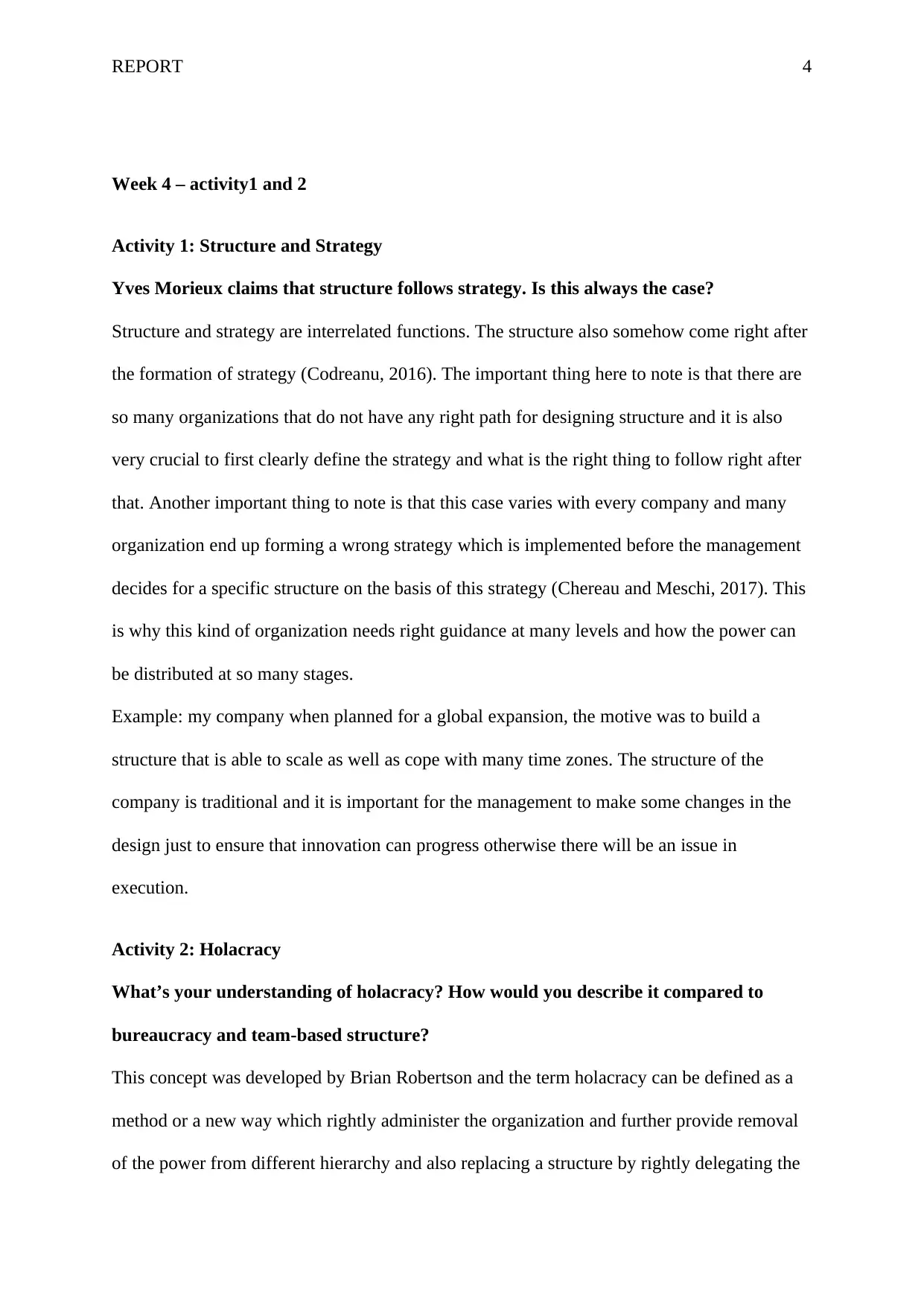
REPORT 4
Week 4 – activity1 and 2
Activity 1: Structure and Strategy
Yves Morieux claims that structure follows strategy. Is this always the case?
Structure and strategy are interrelated functions. The structure also somehow come right after
the formation of strategy (Codreanu, 2016). The important thing here to note is that there are
so many organizations that do not have any right path for designing structure and it is also
very crucial to first clearly define the strategy and what is the right thing to follow right after
that. Another important thing to note is that this case varies with every company and many
organization end up forming a wrong strategy which is implemented before the management
decides for a specific structure on the basis of this strategy (Chereau and Meschi, 2017). This
is why this kind of organization needs right guidance at many levels and how the power can
be distributed at so many stages.
Example: my company when planned for a global expansion, the motive was to build a
structure that is able to scale as well as cope with many time zones. The structure of the
company is traditional and it is important for the management to make some changes in the
design just to ensure that innovation can progress otherwise there will be an issue in
execution.
Activity 2: Holacracy
What’s your understanding of holacracy? How would you describe it compared to
bureaucracy and team-based structure?
This concept was developed by Brian Robertson and the term holacracy can be defined as a
method or a new way which rightly administer the organization and further provide removal
of the power from different hierarchy and also replacing a structure by rightly delegating the
Week 4 – activity1 and 2
Activity 1: Structure and Strategy
Yves Morieux claims that structure follows strategy. Is this always the case?
Structure and strategy are interrelated functions. The structure also somehow come right after
the formation of strategy (Codreanu, 2016). The important thing here to note is that there are
so many organizations that do not have any right path for designing structure and it is also
very crucial to first clearly define the strategy and what is the right thing to follow right after
that. Another important thing to note is that this case varies with every company and many
organization end up forming a wrong strategy which is implemented before the management
decides for a specific structure on the basis of this strategy (Chereau and Meschi, 2017). This
is why this kind of organization needs right guidance at many levels and how the power can
be distributed at so many stages.
Example: my company when planned for a global expansion, the motive was to build a
structure that is able to scale as well as cope with many time zones. The structure of the
company is traditional and it is important for the management to make some changes in the
design just to ensure that innovation can progress otherwise there will be an issue in
execution.
Activity 2: Holacracy
What’s your understanding of holacracy? How would you describe it compared to
bureaucracy and team-based structure?
This concept was developed by Brian Robertson and the term holacracy can be defined as a
method or a new way which rightly administer the organization and further provide removal
of the power from different hierarchy and also replacing a structure by rightly delegating the
Paraphrase This Document
Need a fresh take? Get an instant paraphrase of this document with our AI Paraphraser
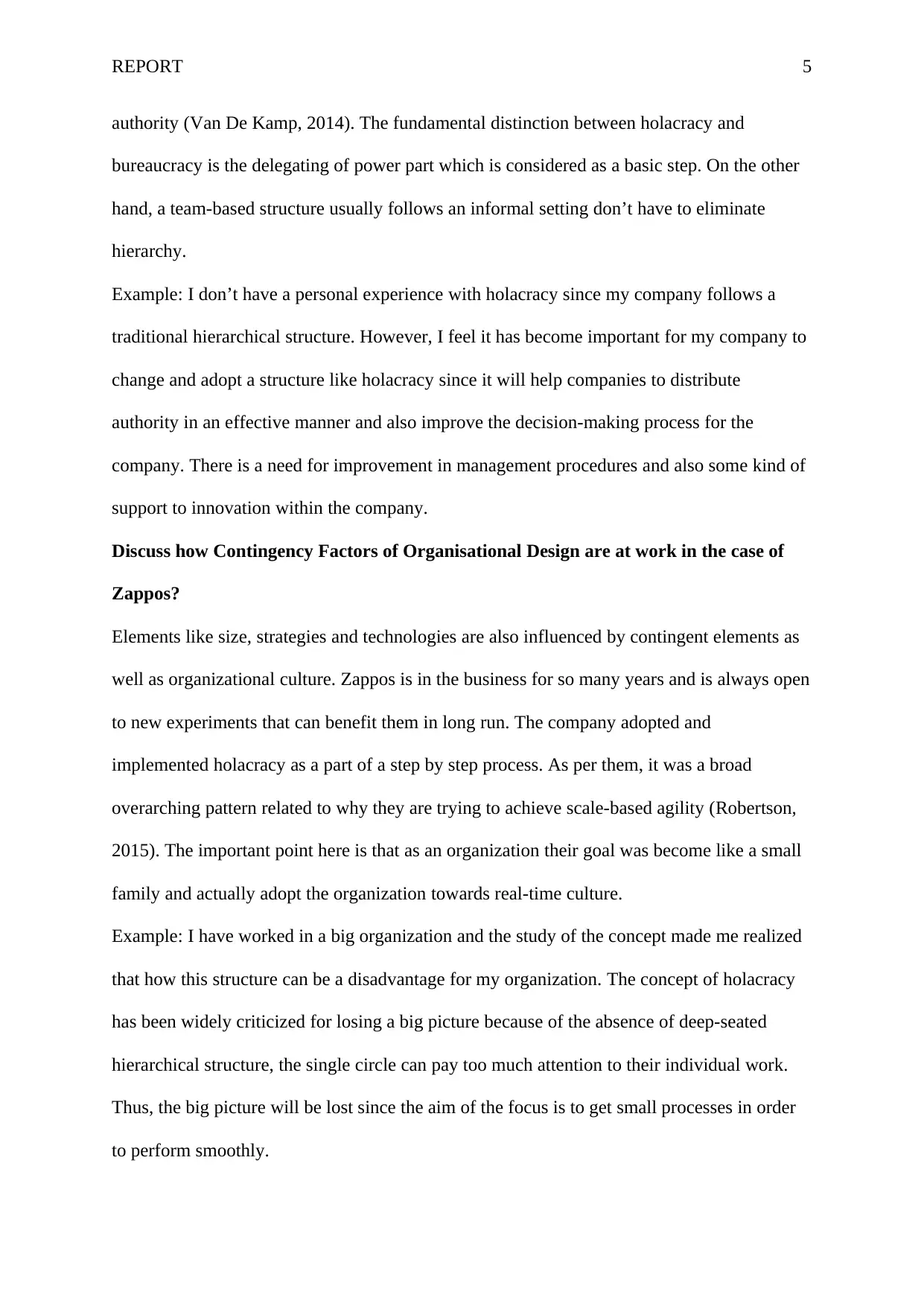
REPORT 5
authority (Van De Kamp, 2014). The fundamental distinction between holacracy and
bureaucracy is the delegating of power part which is considered as a basic step. On the other
hand, a team-based structure usually follows an informal setting don’t have to eliminate
hierarchy.
Example: I don’t have a personal experience with holacracy since my company follows a
traditional hierarchical structure. However, I feel it has become important for my company to
change and adopt a structure like holacracy since it will help companies to distribute
authority in an effective manner and also improve the decision-making process for the
company. There is a need for improvement in management procedures and also some kind of
support to innovation within the company.
Discuss how Contingency Factors of Organisational Design are at work in the case of
Zappos?
Elements like size, strategies and technologies are also influenced by contingent elements as
well as organizational culture. Zappos is in the business for so many years and is always open
to new experiments that can benefit them in long run. The company adopted and
implemented holacracy as a part of a step by step process. As per them, it was a broad
overarching pattern related to why they are trying to achieve scale-based agility (Robertson,
2015). The important point here is that as an organization their goal was become like a small
family and actually adopt the organization towards real-time culture.
Example: I have worked in a big organization and the study of the concept made me realized
that how this structure can be a disadvantage for my organization. The concept of holacracy
has been widely criticized for losing a big picture because of the absence of deep-seated
hierarchical structure, the single circle can pay too much attention to their individual work.
Thus, the big picture will be lost since the aim of the focus is to get small processes in order
to perform smoothly.
authority (Van De Kamp, 2014). The fundamental distinction between holacracy and
bureaucracy is the delegating of power part which is considered as a basic step. On the other
hand, a team-based structure usually follows an informal setting don’t have to eliminate
hierarchy.
Example: I don’t have a personal experience with holacracy since my company follows a
traditional hierarchical structure. However, I feel it has become important for my company to
change and adopt a structure like holacracy since it will help companies to distribute
authority in an effective manner and also improve the decision-making process for the
company. There is a need for improvement in management procedures and also some kind of
support to innovation within the company.
Discuss how Contingency Factors of Organisational Design are at work in the case of
Zappos?
Elements like size, strategies and technologies are also influenced by contingent elements as
well as organizational culture. Zappos is in the business for so many years and is always open
to new experiments that can benefit them in long run. The company adopted and
implemented holacracy as a part of a step by step process. As per them, it was a broad
overarching pattern related to why they are trying to achieve scale-based agility (Robertson,
2015). The important point here is that as an organization their goal was become like a small
family and actually adopt the organization towards real-time culture.
Example: I have worked in a big organization and the study of the concept made me realized
that how this structure can be a disadvantage for my organization. The concept of holacracy
has been widely criticized for losing a big picture because of the absence of deep-seated
hierarchical structure, the single circle can pay too much attention to their individual work.
Thus, the big picture will be lost since the aim of the focus is to get small processes in order
to perform smoothly.
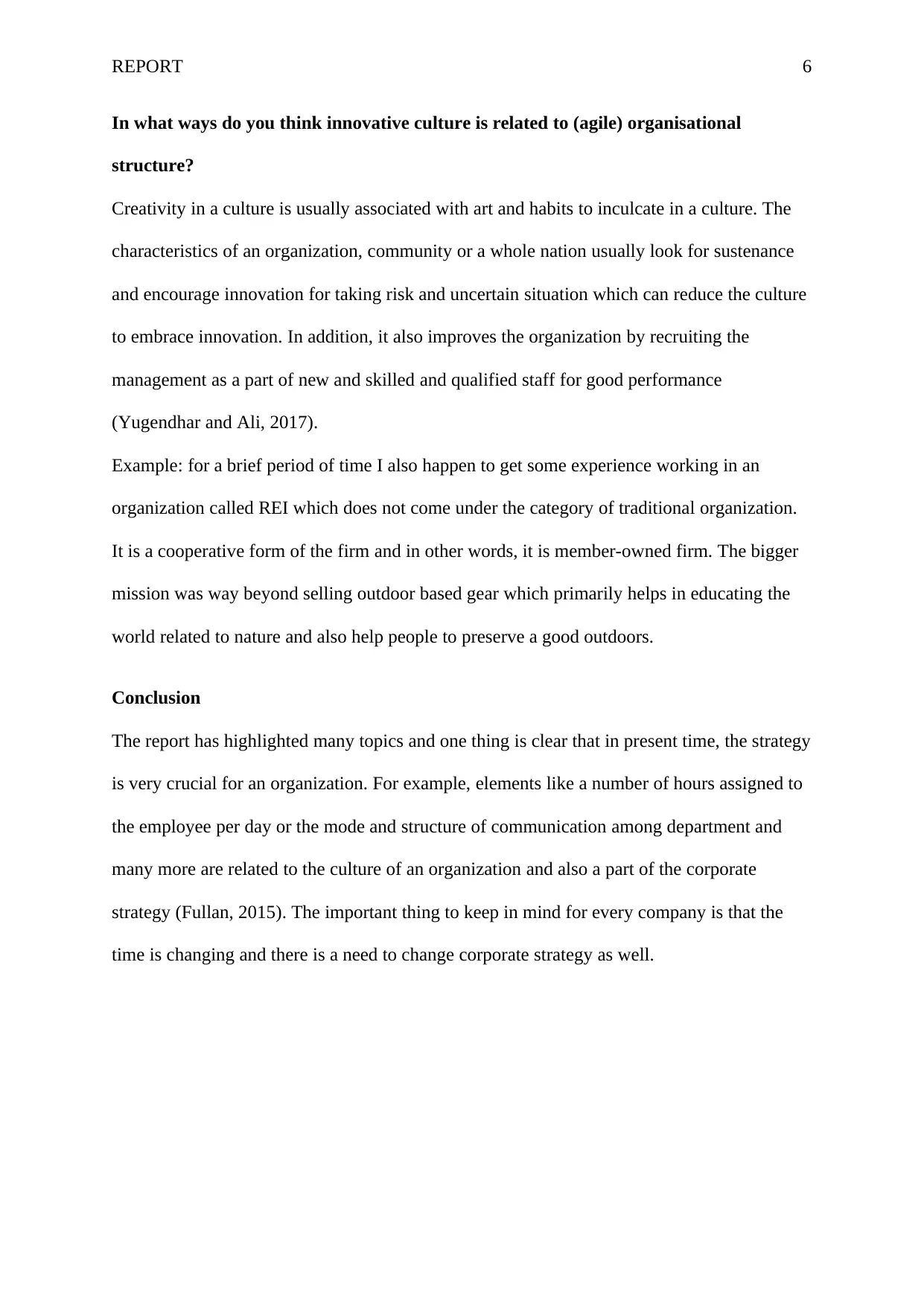
REPORT 6
In what ways do you think innovative culture is related to (agile) organisational
structure?
Creativity in a culture is usually associated with art and habits to inculcate in a culture. The
characteristics of an organization, community or a whole nation usually look for sustenance
and encourage innovation for taking risk and uncertain situation which can reduce the culture
to embrace innovation. In addition, it also improves the organization by recruiting the
management as a part of new and skilled and qualified staff for good performance
(Yugendhar and Ali, 2017).
Example: for a brief period of time I also happen to get some experience working in an
organization called REI which does not come under the category of traditional organization.
It is a cooperative form of the firm and in other words, it is member-owned firm. The bigger
mission was way beyond selling outdoor based gear which primarily helps in educating the
world related to nature and also help people to preserve a good outdoors.
Conclusion
The report has highlighted many topics and one thing is clear that in present time, the strategy
is very crucial for an organization. For example, elements like a number of hours assigned to
the employee per day or the mode and structure of communication among department and
many more are related to the culture of an organization and also a part of the corporate
strategy (Fullan, 2015). The important thing to keep in mind for every company is that the
time is changing and there is a need to change corporate strategy as well.
In what ways do you think innovative culture is related to (agile) organisational
structure?
Creativity in a culture is usually associated with art and habits to inculcate in a culture. The
characteristics of an organization, community or a whole nation usually look for sustenance
and encourage innovation for taking risk and uncertain situation which can reduce the culture
to embrace innovation. In addition, it also improves the organization by recruiting the
management as a part of new and skilled and qualified staff for good performance
(Yugendhar and Ali, 2017).
Example: for a brief period of time I also happen to get some experience working in an
organization called REI which does not come under the category of traditional organization.
It is a cooperative form of the firm and in other words, it is member-owned firm. The bigger
mission was way beyond selling outdoor based gear which primarily helps in educating the
world related to nature and also help people to preserve a good outdoors.
Conclusion
The report has highlighted many topics and one thing is clear that in present time, the strategy
is very crucial for an organization. For example, elements like a number of hours assigned to
the employee per day or the mode and structure of communication among department and
many more are related to the culture of an organization and also a part of the corporate
strategy (Fullan, 2015). The important thing to keep in mind for every company is that the
time is changing and there is a need to change corporate strategy as well.
⊘ This is a preview!⊘
Do you want full access?
Subscribe today to unlock all pages.

Trusted by 1+ million students worldwide
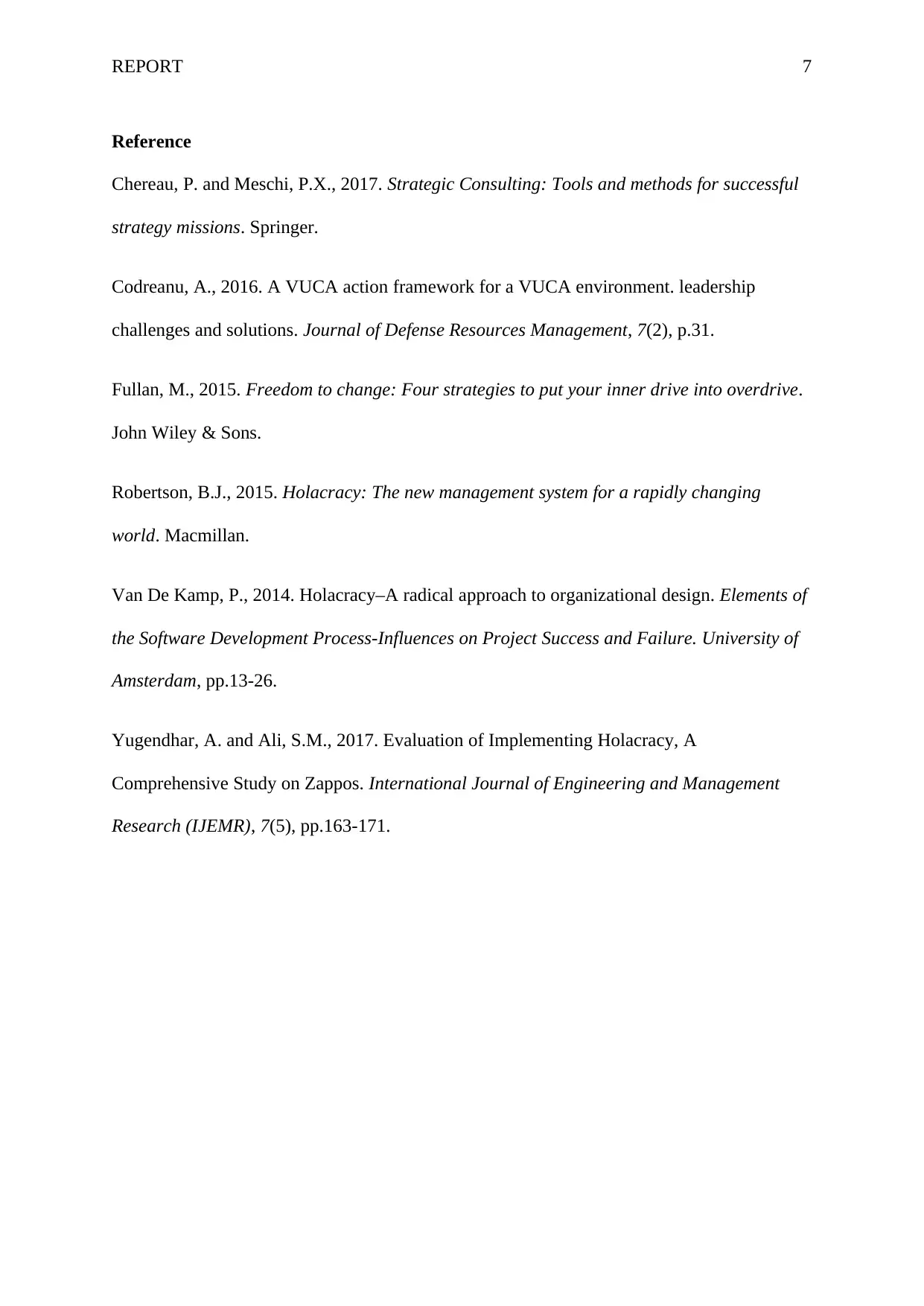
REPORT 7
Reference
Chereau, P. and Meschi, P.X., 2017. Strategic Consulting: Tools and methods for successful
strategy missions. Springer.
Codreanu, A., 2016. A VUCA action framework for a VUCA environment. leadership
challenges and solutions. Journal of Defense Resources Management, 7(2), p.31.
Fullan, M., 2015. Freedom to change: Four strategies to put your inner drive into overdrive.
John Wiley & Sons.
Robertson, B.J., 2015. Holacracy: The new management system for a rapidly changing
world. Macmillan.
Van De Kamp, P., 2014. Holacracy–A radical approach to organizational design. Elements of
the Software Development Process-Influences on Project Success and Failure. University of
Amsterdam, pp.13-26.
Yugendhar, A. and Ali, S.M., 2017. Evaluation of Implementing Holacracy, A
Comprehensive Study on Zappos. International Journal of Engineering and Management
Research (IJEMR), 7(5), pp.163-171.
Reference
Chereau, P. and Meschi, P.X., 2017. Strategic Consulting: Tools and methods for successful
strategy missions. Springer.
Codreanu, A., 2016. A VUCA action framework for a VUCA environment. leadership
challenges and solutions. Journal of Defense Resources Management, 7(2), p.31.
Fullan, M., 2015. Freedom to change: Four strategies to put your inner drive into overdrive.
John Wiley & Sons.
Robertson, B.J., 2015. Holacracy: The new management system for a rapidly changing
world. Macmillan.
Van De Kamp, P., 2014. Holacracy–A radical approach to organizational design. Elements of
the Software Development Process-Influences on Project Success and Failure. University of
Amsterdam, pp.13-26.
Yugendhar, A. and Ali, S.M., 2017. Evaluation of Implementing Holacracy, A
Comprehensive Study on Zappos. International Journal of Engineering and Management
Research (IJEMR), 7(5), pp.163-171.
1 out of 7
Related Documents
Your All-in-One AI-Powered Toolkit for Academic Success.
+13062052269
info@desklib.com
Available 24*7 on WhatsApp / Email
![[object Object]](/_next/static/media/star-bottom.7253800d.svg)
Unlock your academic potential
Copyright © 2020–2025 A2Z Services. All Rights Reserved. Developed and managed by ZUCOL.




